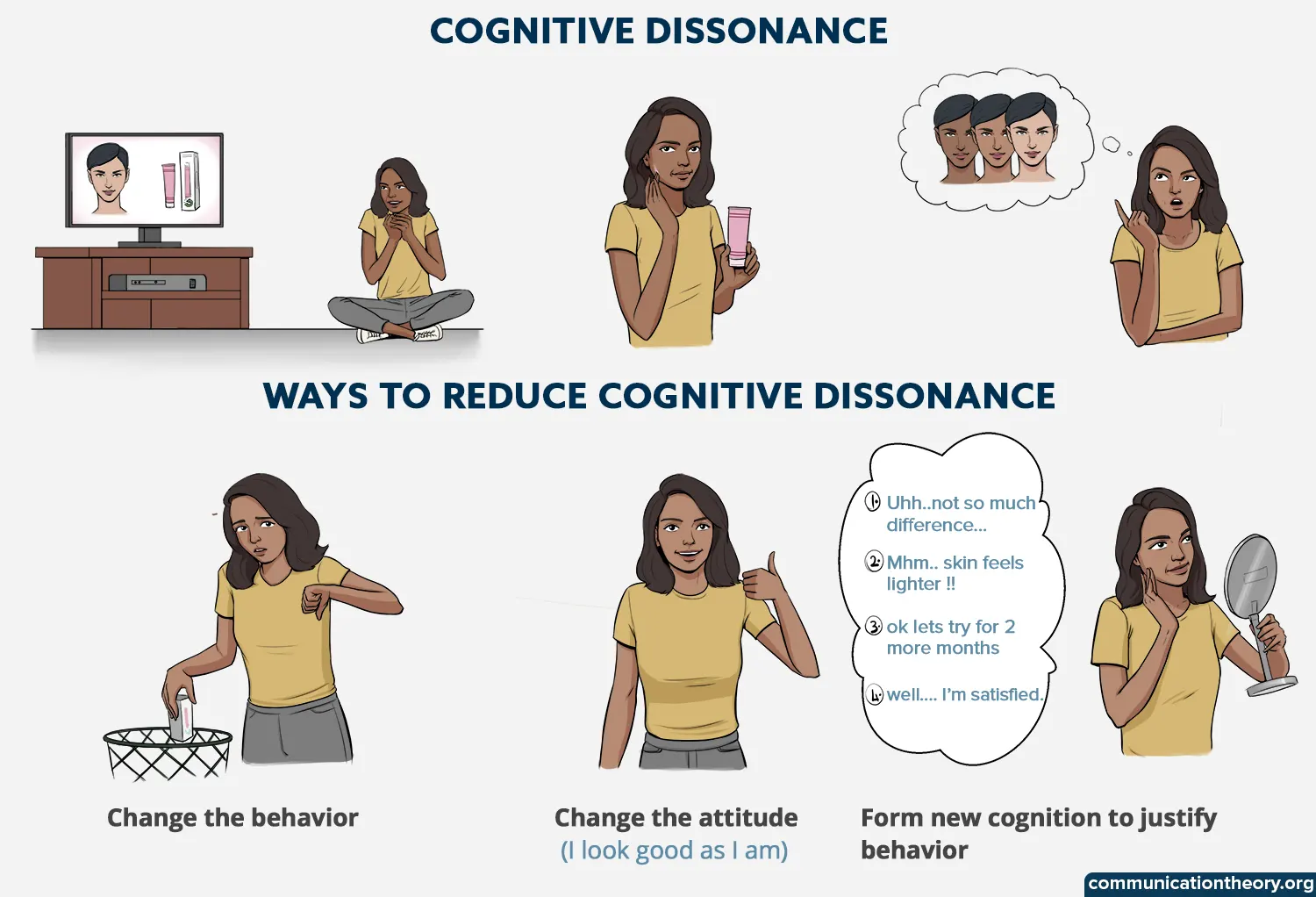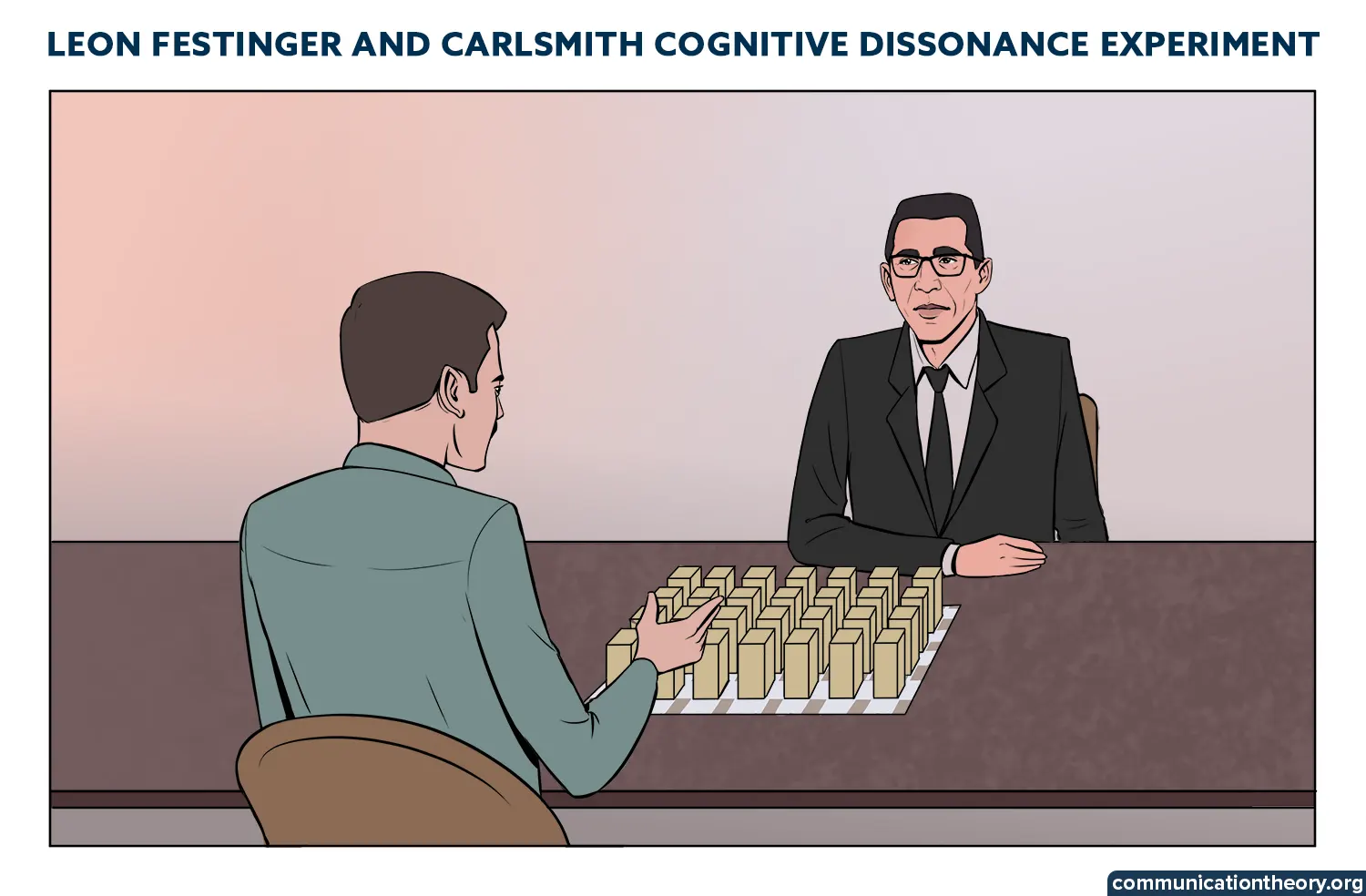Amy is well aware of the benefits of engaging in some form of physical activity. Yet, she wakes up feeling zero motivation to move her body an inch. So she chooses to stick to her daily routine of waking up, glugging down a mug of cold coffee and driving her way to the office. She feels guilty about it every single day and decides things will change tomorrow.

Source: llhedgehogll/Adobe Stock
Many a time we find ourselves stuck in between a belief and behavior; both of which seem convincing. We may experience the intense urge to do a certain thing, but that behavior might be contrary to our morals and values.
The mental clash or tension resulting from the processes of acquiring knowledge or understanding through the senses is called cognitive dissonance. In simple, the clash of minds when we must choose from the choices can be called as cognitive dissonance.
Many of us have been here yet do not know it is a well-known concept backed up by research.
What is Cognitive Dissonance?
Cognitive dissonance is a theory proposed by Leon Festinger in the 1950s. He talks about this theory in detail in his book “A theory of cognitive dissonance”. He is well known for his theories of “Cognitive Dissonance and Social Comparison”. He is also responsible for the discovery of the relevance of propinquity (Close relationship) in the formation of social ties and bonds.
In this theory, he states that cognitive dissonance is a state of non-equilibrium where the behaviors and attitudes are inconsistent with one another. In simpler terms, when a person engages in a behavior that does not match their beliefs and moral values, they tend to experience a psychological discomfort which is termed cognitive dissonance.
This is the feeling of discomfort from two conflicting thoughts, it may increase or decrease according to the following factors
- The relevance of the subject to us.
- How solid the choices or thoughts are.
- The capability of our mind to choose, rationalize or explain our thoughts.
For example, Sara didn’t enjoy gossiping or making bad remarks about others as she believed in being kind and loving towards everyone. But when she was surrounded by her friends, she engaged in it anyway just so that she could fit in with them.
When people are confronted with dissonance, they fall into a state of psychological discomfort where their consistent state of equilibrium becomes precarious. As a result, they experience intense anxiety or a state of tension or other physiological symptoms which indicate that there is a change in the inner system. The dissonance will be at its highest on matters regarding self-image.
To bring themselves back to their perceived state of equilibrium, this person may either change their behavior or rationalize their decision by attempting to alter their belief system and moral values.
Strategies humans use to overcome cognitive dissonance
The theory states that we are possessed with a powerful drive to maintain cognitive steadiness and reliability which may sometimes become irrational. The mind will attain its harmony by the following steps.
- Change the conflicting behavior to make it consistent with their beliefs.
- Change the current cognition to defend the attitude-discrepant behavior.
- Form new cognitions to justify their attitude-discrepant behaviors.

For example, Bella is a strong-minded and highly opinionated person. Her behaviors directly reflected her beliefs, values and standards that she has set for herself. But her sudden need for a bulk amount of money put her morals to question.
She was well aware of the fact that her current job wouldn’t help her amass the amount that she’s currently in need of.
A friend gives her a choice to help hand over a few grams of an illegal drug to an anonymous person and that would pay more than she needs. But this transaction goes completely against the standards that Bella has set for herself.
In this situation, she can either choose to follow her morals and find an alternative that would align with her beliefs. Or she could choose to justify her behavior by emphasizing the criticality of her situation or she could choose to accommodate a new belief that engaging in such an attitude-discrepant behavior for a do or die the situation is not so wrong after all.
Research related to cognitive dissonance
Physiological arousal
Various studies have been undertaken to prove that cognitive dissonance leads to specific physiological responses in the form of arousal. Researchers studied the brain waves of those who engaged in unpleasant tasks that weren’t justified enough and found a lower level of alpha waves in their neural activity. Researchers also observed pupil dilation in some when performing an unpleasant task.
Cognitive dissonance and smoking
Research show that the level of factual knowledge in regards to the ill effects of smoking seems to be the same among smokers and non-smokers. However, it was found that smokers had more distorted thinking about smoking and attempted to rationalize their smoking behavior compared to non-smokers and ex-smokers.
Cognitive dissonance and consumer behavior
Cognitive dissonance has one of its vital implications in the field of consumer behaviorism. Consumers tend to assess and evaluate the various options available in the market and choose one that fits their idea of perfection. After deciding to purchase a product, however, they feel that they chose to purchase that product due to the pressure placed on them by the seller.
Hence, they are very likely to experience dissonance when there is a wide gap between their expectations and the real nature of the product. They regret their decision of having chosen a certain brand instead of an alternative brand which seems to offer more for the price paid.
Cognitive dissonance in romantic relationships
Cognitive dissonance is likely to happen even in day-to-day events regarding relationships and various other areas of life. Small examples from real-life situations can also put us in a state of dissonance where we are coerced to choose between two difficult choices.
As any relationship matures, we are made the face the reality of differences in the beliefs, attitudes, and behaviors of our close ones in comparison to what we believed they were.
For example, John and Maria were in a happy relationship and one day they decided to meet at a fancy restaurant to celebrate their six-month anniversary. John was present on time and he waited for Maria to join him soon. He waited for two hours straight and Maria wouldn’t pick up his calls either. Finally, as she came in, John enquired about what took her so long. Maria got heated and she called him names in front of the whole crowd and stomped out of the restaurant angrily.
In this situation, John is in a state of dissonance as he was visibly shocked by Maria’s behavior. He could either choose to rationalize the entire incident or choose to leave Maria.
When do people engage in attitude-discrepant behaviors?
People engage in attitude-discrepant behaviors when the behavior seems good or appealing to them and when the attitude isn’t strong enough to hinder them from engaging in certain behavior. Cognitive dissonance is experienced at a higher intensity when there are very few reasons to justify the behavior.
An interesting study conducted by Festinger and Carlsmith proves this assumption.
- Two groups of participants were asked to engage in a series of extremely boring tasks such as turning pegs in a board of holes.
- The researchers hence requested a favor from the participants since the research assistant was absent.
- They asked the participants to brief the experiment and claim that it was an interesting one for the upcoming participants.
- Researchers announced to one group of participants that they would be given $20 to make that pitch; whereas the other group would be paid $1 to do the same.
- Just as the researchers expected, the group which was paid $1 rated the task as more interesting and made a better pitch compared to the other group.

Such a result was observed because the group of people who were paid $1 had no valid justification to claim that the task was interesting. Hence, they chose to alter their attitude toward the task to bring them back to a state of equilibrium and not feel that they were making a false claim. Researchers later came to call this phenomenon a “less-leads-to-more effect”.
What determines the intensity of the cognitive dissonance experienced?
This theory claims that the stronger the belief, the weaker the cognitive dissonance is and the weaker the attitude, the stronger is the cognitive dissonance.
For example, Joe strongly believed that being kind is one of the most essential aspects of being a good human. So, when he lashed out at his friend for calling him continuously, he felt extremely guilty for his impulsive behavior and wished he could’ve been calmer during that situation.
Can cognitive dissonance be used for positive behavioral outcomes?
Researchers wanted to investigate whether cognitive dissonance can be beneficial and can lead to positive changes in the community. Through their study, they concluded that cognitive dissonance can be employed in specific situations to elicit a feeling of “hypocrisy” in the participants which would, in turn, pave way for behavioral changes.
A study conducted by Stone, Wiegand, Cooper, and Aronson (1997)
Experiment
The participants were asked to make a videotape discussing the importance of using condoms to avoid contracting AIDS. Later, two groups of participants were asked about the reasons behind not using condoms in the past and also insisted to buy and use condoms in the future.
Interpretation
Researchers predicted that the participants who were made to give personal reasons would be more likely to purchase condoms in comparison to the group that was asked for a generalized reason.
Conclusion
When people were made to see their attitude-discrepant behavior face-to-face, they felt hypocritical about themselves and wanted to align their attitudes and behavior by choosing to reform their behaviors.
Criticism of Cognitive Dissonance Theory
This is the reason why we human beings tend to justify ourselves. This theory is subjective because we cannot physically observe cognitive dissonance so we cannot obtain any objective measurements. It has a sort of vagueness in its nature because every people will have their differences always.
That is true,every like to see what he/she thinking is better than of other,but the important here is to test our thought with the experience of others and praying wisdom from God.
Very shortly this web page will be famous among all blog viewers, due to it’s good articles
This page is very informative and rich in academic discourse.If you are using it,you are certainly the best in the market place of academic discipline.
please give more examplessss… ghehee
thanks a lot
very helpful thank you so much….
Very useful material here for me
It is gregarious Learning from this theory.
it is gregarious having residual knowledge on this theory
I enjoyed this side
This is a very good suppliment about the theory
Nice one keep it up
Thanx
I understand the topic about communication skill
Thank you for the infomation